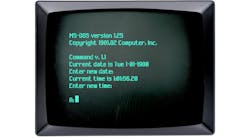This article is part of the Library Series: Electronics History and Then and Now.
What you’ll learn:
- How was DOS part of the PC revolution?
- Is DOS still around?
- What did Bill write a long time ago?
Remember the DOS prompt?
DOS stands for disk operating system. The latest announcement is a blast from the past. You can now get the source code for MS-DOS v1.25, v2.0, and v4.0 from github.com courtesy of Microsoft.
Unfortunately, DOS 5 and 6 aren’t there yet, but maybe sometime in the future. If my first book, Program Interfacing to MS-DOS (ISBN 9780934375634, M&T Publishing, 1987), wasn’t out of print, I could make a fortune. If you’re really into DOS, then you can check out my contribution to The MS-DOS Encyclopedia from the Microsoft Programmer’s Library CD. It’s the third article.
Unless you were born a long time ago, you may not have encountered Microsoft’s DOS. DOS came in different flavors like PC-DOS and MS-DOS, and plenty of articles cover its development and deployment.
Combined with Intel’s hardware, IBM PC DOS was the basis for the PC revolution. It was easy to implement and not too hard to use given its text-based roots. The system was the host for the original version of Windows that’s grown into Windows 11. It’s still possible to run a DOS-compatible environment in a Windows window and emulators like rpix86 and DOSEMU can run DOS applications on other platforms.
The original versions of DOS came on floppy disks—first 5.25-in. and then 3.25-in. versions. DOS can even boot from USB flash drives; I have a bunch that were used to update the Basic Input/Output System (BIOS) of many a PC. American Megatrends, Award, and Phoenix Technologies were well-known BIOS supplies that allowed any version of DOS to boot and run on an x86 system. Of course, it used a 16-bit version that was significantly slower and less powerful than today’s 64-bit systems.
It’s still possible to use MS-DOS 6 and open-source alternatives like FreeDOS are being actively supported.
Following the Legacy
Ever wonder why we have so many three-character filename extensions like .EXE, .TXT and .DOC?
The original DOS FAT file system limited the filename to eight characters with an extension of three characters. Programs were .COM files and .BAT represented text scripts or batch files. Even the FAT file system evolved over time to accommodate larger disks.
Part of the challenge was running DOS at 64 kB or less. It’s essentially on par with many RTOSes used on systems these days, and DOS was written in assembler. Using C on some systems required multiple floppy-disk changes and programming languages like BASIC from various sources, including Microsoft’s GW-BASIC. PC-BASIC is an open-source incarnation.
You could run all sorts of useful applications on DOS as well as character- and graphic-based games like Doom. Video hardware compatibility was the challenge for some advanced DOS games, but the basic IBM PC graphics let most games and applications work on most any hardware. Things got more complicated as the hardware improved and Windows with graphic device drivers came into play. Check out “The Graphic Chip Chronicles” if you want to see how the GPU side of things changed over time.
Head over to “Do You Recognize These?” if you think you identify with things like early 8-bit micros. Keep in mind that DOS ran on an Intel 8088 or 8086 and there were compatible x86 chips as well. On top of that, extensions enabled the 16-bit DOS to access a PC’s 640 kB of RAM.
Hosting MS-DOS
I was involved with various aspects of DOS in addition to my first book. I also wrote for many magazines back then with encouragement by Sol Libes, a major player in the early PC industry. He co-founded the Trenton Computer Festival, “the oldest and longest running Personal Computer show in the world.” My first book came from articles I did for Microsystems magazine, which Sol started in 1979.
The articles and book were the result of work I did with a friend in writing custom BIOS configurations for hardware vendors at the time. This was all assembler work with COBOL, FORTRAN, and ALGOL being the mini and mainframe languages until C started to emerge.
Now for a Little Feedback Loop
By the way, you can still find my last book, Windows 2000 DNS Server, on Amazon. although I don’t get anything from it any more. That’s assuming you can find a copy of it.
Add a comment or two and take our quick poll if you get a chance. I would love to hear what others think of this legacy software.
Read more articles in the Library Series: Electronics History and Then and Now.
